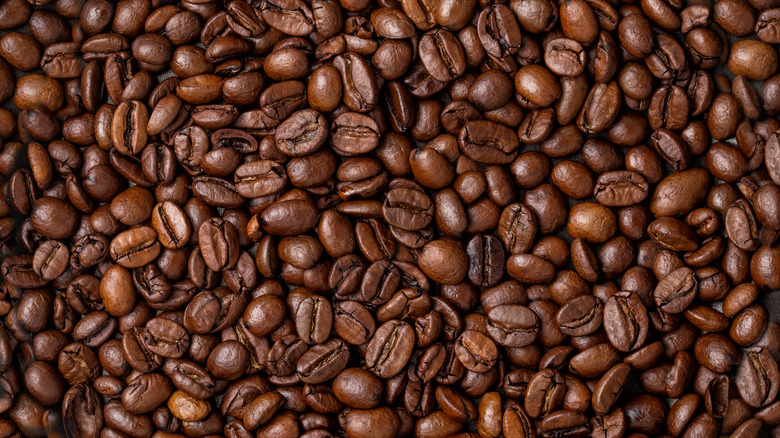Why Are Some Coffee Beans Shiny And Others Aren't?
Admittedly, the first thing you're likely to notice when opening a new bag of whole coffee beans is the aroma, but at some point you're likely to make at least a cursory visual inspection before grinding, at which point you'll notice a very curious anomaly. Some beans are shiny and some aren't. Here's why.
Oiliness on coffee beans is not a guarantee of freshness, or the reverse. Rather, as El Molino Coffee notes, shiny beans are "the result of flavor oils and lipids that have risen to the surface from inside the beans' cellular structure during the roasting process."
Sound distressingly scientific? It's actually not as complicated as it might sound. Roasting is an important part of the process between the harvesting of raw beans and the final product: your morning cup of joe. It's done at high temperatures – typically between 370 and 540 degrees Fahrenheit, per Coffee Affection. During this high heat, coffee beans undergo what is known as the Maillard reaction. This is how coffee derives its distinctly caramelized taste. But as coffee beans' structure breaks down under the intense heat of roasting, that's when the oils can rise to the surface.
Why you should be careful with shiny coffee beans
So now you know why the oils leak out and make some beans shiny. But does it mean anything? Well, for starters, you're unlikely to see this shininess on lighter roasted beans, according to El Molino Coffee, because it evaporates so quickly in an oxygen-rich environment. The oiliness is slower to evaporate in dark-roasted beans; indeed, it cannot do so once they're packaged with an airtight seal, which is why some dark-roasted beans can remain oily until the moment you open the bag in your kitchen.
That being said, you should definitely be careful and avoid shiny beans when grinding, since as Coffee Affection observes, they can end up clogging your grinder. This is the problematic part, since per Coffee Beans 101, shiny beans leave a greasy residue that can affect the grinder long-term. So, how do you avoid eventual clogging and other issues? If you like the taste of dark-roasted coffees and prefer them to lighter roasts where shiny beans aren't an issue, then you need to be much more cognizant, both with removing shiny beans, and the regular care and cleaning of your grinder.

